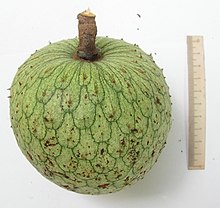Annona montana, the mountain soursop, is a tree and its edible fruit in the Annonaceae family native to Central America, the Amazon, and islands in the Caribbean. It has fibrous fruits.[4] A. montana may be used as a rootstock for cultivated Annonas.[5]
| Annona montana | |
|---|---|

| |
| Scientific classification | |
| Kingdom: | Plantae |
| Clade: | Tracheophytes |
| Clade: | Angiosperms |
| Clade: | Magnoliids |
| Order: | Magnoliales |
| Family: | Annonaceae |
| Genus: | Annona |
| Species: | A. montana
|
| Binomial name | |
| Annona montana | |
| Synonyms | |
|
Annona marcgravii Mart.[2] | |

Etymology and common names
editThe Latin specific epithet montana refers to mountains or "coming from mountains".[6]
- English: mountain soursop, mountain sop, wild soursop
- Czech: mountain soursop
- German: Schleimapfel
- Spanish: guanábana cimarrona, guanábana, guanábana de loma, guanábana de monte, guanábana de perro, taragus, turagua
- French: corossolier bâtard
- Guarani: araticu
- Hungarian: hegyi annóna
- Portuguese: araticum, araticum açú, araticum apé
- Slovak: anona[7][8]
Description
editThe tree is similar to Annona muricata, but has a more spreading crown and glossy leaves. It is slightly hardier and bears fruit throughout the year.[9] It tolerates brief temperature drops down to 24 °F (−4 °C) when full grown.[10] Its pollen is shed as permanent tetrads.[11] The fruits are nearly round, with dark green skin covered with many short fleshy spines, and are about 15 centimetres (5.9 in) long. Yellow, fibrous pulp – which is aromatic – is sour and bitter, containing many light-brown, plump seeds.[9] There is history of its use as a traditional medicine.[9]
Distribution
editA. montana grows wild at altitudes from 0 metres (0 ft) to 650 metres (2,130 ft).[9] Its natural distribution is:
- Caribbean: West Indies
- Central America: Costa Rica, Panama
- South America: Bolivia, Colombia, Ecuador, Peru, Venezuela, Brazil[2][12]
- United States: Southern Florida[9]
See also
editReferences
edit- ^ Verspagen, N.; Erkens, R.H.J. (2020). "Annona montana". IUCN Red List of Threatened Species. 2020: e.T142423951A142423971. doi:10.2305/IUCN.UK.2020-2.RLTS.T142423951A142423971.en. Retrieved 19 November 2021.
- ^ a b "Annona montana". Germplasm Resources Information Network. Agricultural Research Service, United States Department of Agriculture. Retrieved 2008-04-18.
- ^ W3tropicos. "Annona montana Macfad". Missouri Botanical Garden Press. Retrieved 2008-04-18.
{{cite web}}: CS1 maint: numeric names: authors list (link) - ^ Cassidy, Frederic Gomes (2002) [1967]. "Mountain Witch". A Dictionary of Jamaican English. University of the West Indies Press. ISBN 976-640-127-6.
- ^ Llamas, Kirsten Albrecht (2003). "Annonaceae". Tropical Flowering Plants: A Guide to Identification and Cultivation. University of the West Indies Press. ISBN 0-88192-585-3.
- ^ Archibald William Smith A Gardener's Handbook of Plant Names: Their Meanings and Origins, p. 239, at Google Books
- ^ Food and Agriculture Organization of the United Nations (2007-11-21). "Thesaurus, FAO". AGROVOC. United Nations. Retrieved 2008-04-18.
- ^ Bioversity International. "Result set for: Annonaceae Annona montana". New World Fruits Database. Retrieved 2008-04-18. [dead link]
- ^ a b c d e Morton, Julia F (1999-04-02). "Wild Custard Apple". New Crops. Department of Horticulture and Landscape Architecture, Purdue University. pp. 86–88. Archived from the original on 9 May 2008. Retrieved 2008-04-18.
- ^ "Mountain Soursop - Annona montana". Trade Winds Fruit. Retrieved 15 February 2019.
- ^ Tsou, C.-H.; Fu, Y.-L. (2002). "Tetrad pollen formation in Annona (Annonaceae): proexine formation andbinding mechanism". American Journal of Botany. 89 (5): 734–747. doi:10.3732/ajb.89.5.734. ISSN 0002-9122. PMID 21665673.
- ^ "Annona montana". Useful Tropical Plants. Retrieved 15 February 2019.
Data related to Annona montana at Wikispecies
